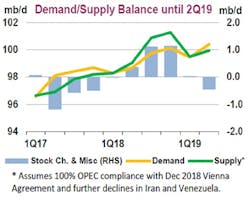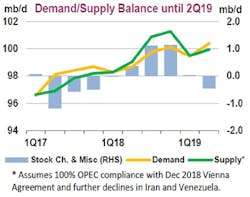IEA: Rebalancing of global oil market to be gradual
Despite the signing of a new Vienna Agreement, the journey to a balanced global oil market will take time and is more likely to be a marathon than a sprint, according to the International Energy Agency’s first Oil Market Report in 2019.
On the supply side, IEA said, “While Saudi Arabia is determined to protect its price aspirations by delivering substantial production cuts, there is less clarity with regard to its Russian partner.”
Data show that Russia increased crude oil production in December to a new record near 11.5 million b/d and it is unclear when it will cut and by how much. Other nonmembers of the Organization of Petroleum Exporting Countries joining in the output deal saw higher output, including Mexico.
There are also signs elsewhere that market rebalancing will be gradual, IEA said. The trajectory of Iran’s production and exports remains important. In December, total Iranian exports increased slightly to more than 1.3 million b/d. With US waivers allowing Iran’s major customers to buy higher volumes than was previously thought, more oil will remain in the market in the early part of this year.
Venezuela has seen the collapse of its oil industry slow during the second half of 2018 with production falling recently by about 10,000 b/d each month rather than by the 40,000 b/d we saw earlier in the year.
The level of output from the US—the world’s biggest liquids producer—will once again be a major factor in 2019. Total liquids production rose 2.1 million b/d in 2018. For this year, IEA has left unchanged for now its forecast for growth of 1.3 million b/d.
“While the other two giants voluntarily cut output, the US, already the biggest liquids supplier, will reinforce its leadership as the world’s No. 1 crude producer. By the middle of the year, US crude output will probably be more than the capacity of either Saudi Arabia or Russia,” IEA said.
The oil demand picture also is mixed. Falling prices in the last quarter of 2018 helped consumers, and there are signs that trade tensions might be easing. In many developing countries, lower international oil prices coincide with a weaker dollar as the likelihood of higher US interest rates fades for now. However, “the mood music in the global economy is not very cheerful,” IEA said. Confidence is weakening in several major economies.
In the short term, there is added uncertainty about oil demand due to the onset of the northern hemisphere winter season, with low temperatures seen in the past few days in many places.
Benchmark crude oil futures prices fell to a 16-month low at yearend 2018. Since the beginning of 2019, they have gained more than 10% and Brent crude is currently close to $60/bbl.
Key IEA numbers
For now, IEA’s estimates that global oil demand growth in 2018 and 2019 will remain unchanged at 1.3 million b/d and 1.4 million b/d, respectively. “The impact of higher oil prices in 2018 is fading, which will help offset lower economic growth,” IEA explained.
Countries that aren’t a part of the Organization for Economic Cooperation and Development will dominate oil demand growth in 2019, with the 875,000 b/d seen last year accelerating to 1.15 million b/d. China and India provide 62% of the total. OECD growth will slow from 390,000 b/d in 2018 to 280,000 b/d in 2019. The US provides 82% of the OECD total.
Global oil supply fell by 950,000 b/d in December 2018, led by lower OPEC output ahead of new supply cuts. At 100.6 million b/d, supply was up 2.8 million b/d vs. a year ago.
OPEC crude oil output dropped by 590,000 b/d in December, to 32.39 million b/d. Saudi Arabia cut back from record highs while Iran and Libya saw further losses. OPEC production is set to fall further in January, when new Vienna Agreement cuts take effect.
Non-OPEC production achieved annual gains of a record 2.6 million b/d in 2018. The US accounted for 2.1 million b/d of the increase, while Canada expanded by 360,000 b/d, Russia by 170,000 b/d, global biofuels by 160,000 b/d, and Kazakhstan by 85,000 b/d.
Non-OPEC production growth is set to slow to 1.6 million b/d in 2019. Production is already set to see a marked decline in January, when the Vienna Agreement output cuts as well as mandatory production curtailments in Alberta take effect. Growth continues to be dominated by the US, even as the pace slows to 1.3 million b/d. Other gains will come from Brazil, where new production units are on track to ramp up. Mexico and Norway remain the largest sources of declines next year, as new projects fail to offset losses from mature fields.
Refining, stocks
According to IEA, global refiners face a challenging year ahead. Processing capacity will increase by 2.6 million b/d—the largest growth in 4 decades—while margins are already pressured by low gasoline crack spreads due to oversupply and weak demand.
The well-trailed changes to the International Maritime Organization’s marine fuel regulations due in 2020 are another big issue for some refiners as they seek to find outlets for unwanted high-sulfur fuel oil.
OECD commercial stocks fell 2.5 million bbl month-on-month in November to 2 857 million bbl. They showed little volatility during 2018, moving within a narrow range of 60 million bbl and likely finishing the year 12 million bbl, or 0.4%, higher than at yearend 2017.

